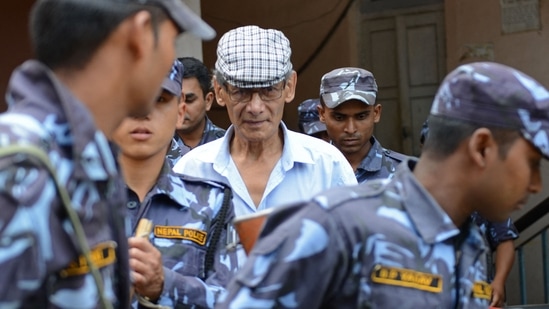Lessons from Charles Sobhraj’s life can bolster justice system
The story of Charles Sobhraj is one of a duplicitous criminal who understood the psychology of the people around him. His eventual release offers us lessons on what to fix and how to go about it.
Charles Gurumukh Sobhraj had already acquired international notoriety when he drugged and robbed a group of French tourists, and killed one of them, in Delhi on June 6, 1976. He had already served his 10-year sentence when he escaped Tihar Jail on March 16, 1986. His arrest 22 days later, and further incarceration only helped him evade a much worse fate in Thailand. He had already been granted bail by the Delhi high court in 1989, but managed to stay in Tihar Jail till 1997, ensuring the lapse of the warrant for murder in Thailand that carried capital punishment.

These are only the Indian examples in the conman’s sparkling and notorious career of evading and manipulating criminal justice jurisdictions in a string of countries, which hold out lessons for the authorities, law enforcement agencies, and the citizen.
Most people remember the maverick criminal for his daring prison break from arguably India’s best protected jail in 1986. It was clear from our investigation at the outset that he planned the elaborate escape, not with the intention of escaping the country, but to forestall the threat of extradition to Thailand, where he may have been hanged due to pending charges for the murder of two tourists. Equally striking was the complete subversion of legal processes inside Tihar Jail that he effected for more than a decade, a revelation that led to an overhaul of prison laws and oversight.
His second act of manipulation came in 1989, when a Delhi court granted him bail on pending charges of abduction, cheating and murder. He refused to deposit the surety amount of ₹50,000 for years, ensuring that he could play for time and wait for charges against him in multiple countries to lapse.
By 1995, the 20-year warrant in Thailand issued through Interpol had expired. Indian law clearly states that a “prisoner is kept in a jail, or in judicial custody, against the warrant(s) issued by any court with respect to the criminal case(s)pending against the person issued by the respective court(s)”. After 1995, a time came when no warrants were pending against him within the country. Yet, by leveraging the delayed furnishing of the bail surety amount, Sobhraj continued to extend his stay in Tihar.
In 1997, the government finally outwitted him. The Centre exercised its powers to deport him to France using an archaic and little known colonial law. The Bengal and Bombay Prisoners Regulation Act(s) of 1817 and 1819 – when read with criminal justice statutes such as the Indian Penal Code, 1860, Indian Police Act, 1861, and relevant procedural and evidence laws – provided for “any person to be placed under personal restraint as a State Prisoner, against whom there was not sufficient ground to institute any judicial proceeding, or such proceeding may not be adapted to the nature of the case, or may for other reasons be unadvisable or improper.” The government declared him a State Prisoner and pushed his deportation through.
The devious man – who was wanted in at least 20 cases of murder, robbery, drugging, cheating, theft, passport forgery and other crimes in countries as diverse as India, France, Greece, Turkey, Afghanistan, Thailand and Nepal – was released in Kathmandu last month after a court order. But his numerous manipulations of criminal justice systems followed in different countries, their varied contexts, and contrasting modes of application, underscored the importance of deeper international cooperation. Every country has its criminal justice system, and its structure, forms and processes vary. Except for the United Nations (UN)-governed International Court of Justice for judicial matters, and Interpol for matters of policing, there is no other body at the global level, even today, to handle issues as delicate and complicated as the cases against Sobhraj, who deftly exploited the inconsistencies and lack of cooperation among agencies and national forces.
The basic principles of criminal law and justice, as outlined in the UN Declaration of Human Rights of 1948, are ethically followed in most countries where the rule of law exists. But often, the legitimate right to defend oneself can be weaponised to deny and subvert justice. In my long career, the murder of Jessica Lal at a party in Delhi, the killing of six people by a BMW car driven by Sanjeev Nanda the same year, and the Romesh Sharma political mafia and murder case, along with the Charles Sobhraj case, exemplified the pitfalls of the criminal justice system, and the opportunities it continues to offer to conmen for misuse.
Our mode of law enforcement — created by a colonial system with the aim of keeping Indians in perpetual subjugation — has four prongs: The police as the prime movers to investigate and enforce criminal laws, the lawyers as prosecutors and defenders of the accused and the victims, the judges as dispensers of justice, and the prisons and correctional services as the repository of the entire process. Unfortunately, despite many efforts, this system continues to throw up examples where the truth can be mutilated and falsified, denying justice to the needy and underprivileged, and serving the interests of the rich and powerful.
The story of Charles Sobhraj is one of a duplicitous criminal who understood the psychology of the people around him, including jail inmates and authorities, the courts and lawyers, and, above all, the Indian police officer, far better than any experts and practitioners. His eventual release offers us lessons on what to fix and how to go about it.
Amod K Kanth is former director-general of police and the author of the soon-to-be-published book, Khaki on Broken Wings: Cases That Shocked India
The views expressed are personal
All Access.
One Subscription.
Get 360° coverage—from daily headlines
to 100 year archives.



HT App & Website







